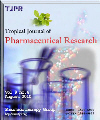
|
Tropical Journal of Pharmaceutical Research
Pharmacotherapy Group, Faculty of Pharmacy, University of Benin, Benin City, Nigeria
ISSN: 1596-5996
EISSN: 1596-5996
Vol. 16, No. 5, 2017, pp. 1167-1172
|
 Bioline Code: pr17149
Bioline Code: pr17149
Full paper language: English
Document type: Research Article
Document available free of charge
|
|
|
Tropical Journal of Pharmaceutical Research, Vol. 16, No. 5, 2017, pp. 1167-1172
| en |
Eosinophilia triggers changes in IL-5, eotaxin and IL-17, and acts as a prognostic biomarker for atopic dermatitis
Wu, Zhi-hong; Zhong, Jiang; Su, Chuan-li; Huang, Yun-shu; Huang, Tao & Xu, Zhang-jie
Abstract
Purpose: To investigate the implication of eosinophilia in atopic dermatitis (AD).
Methods: A total of 139 AD patients from The First Affiliated Hospital of Guangxi University of Chinese
Medicine between February 2013 and May 2015, were involved in this study. Scoring atopic dermatitis
(SCORAD) index was used to evaluate the skin lesions. The levels of IL-4, IL-5, IL-13, IL-17, INF-gamma,
IP-10, eotaxin and Regulated on Activation, Normal T-cell Expressed and Secreted (RANTES),
were determined with commercial enzyme-linked immunosorbent assay (ELISA) kits. Eosinophil counts
were carried out by granulocyte count method. Correlation between SCORAD scores and levels of
cytokines was analyzed using the Spearman correlation method.
Results: SCORAD scores significantly increased in the eosinophil-positive group when compared to
eosinophil-negative group (p < 0.05). Eosinophil counts correlated with SCORAD scores in the
eosinophil-positive group (p < 0.05). INF-γ, IP-10 and RANTES levels were significantly higher in the
eosinophil-positive group than in eosinophil- negative group, while IL-5, eotaxin and IL-17 levels
significantly decreased in eosinophil-positive group (p < 0.05). In the eosinophil-positive group, IL-5,
eotaxin and IL-17 levels positively correlated with SCORAD scores.
Conclusion: Eosinophilia triggers lL-5, eotaxin and IL-17 changes and acts as a prognostic biomarker
for atopic dermatitis. These findings may give further insights into the pathogenesis of AD.
Keywords
Atopic dermatitis; Eosinophilia; SCORAD score; Biomarker; Cytokines
|
| |
© Copyright 2017 - Pharmacotherapy Group, Faculty of Pharmacy, University of Benin, Benin City, 300001 Nigeria.
Alternative site location: http://www.tjpr.org
|
|
